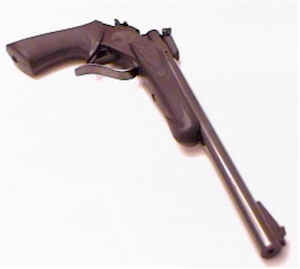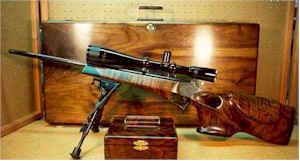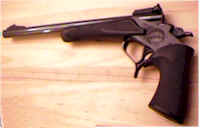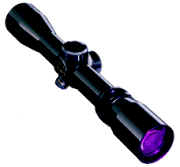
 A Contender is an interesting firearm. It would seem too short to be a proper rifle, too long to be a proper pistol, and maybe an unnecessary compromise at both ends of the spectrum. In fact, it would seem shooting competition with this type of gun is just that, competition that makes sense only for this type of gun.
A Contender is an interesting firearm. It would seem too short to be a proper rifle, too long to be a proper pistol, and maybe an unnecessary compromise at both ends of the spectrum. In fact, it would seem shooting competition with this type of gun is just that, competition that makes sense only for this type of gun.
When used for hunting, the barrels get longer and heavier, as do the cartridges they are chambered for. At some point barrel length grows from long pistol to short rifle, full rifle butt stocks and variable power scopes are added, and the owner has a fine, well… single shot rifle.
 I’ve seen proud owners of Contenders standing next to every form of fallen game from turkey to elephant and brown bear. Some Contenders knock over steel chickens and sheep at very long ranges in silhouette shooting. Contenders have been chambered for cartridges I’m not even sure I would like to fire out of a 8 lb rifle. Some T/C’s are very factory basic. Others become a gunsmith’s work of art.
I’ve seen proud owners of Contenders standing next to every form of fallen game from turkey to elephant and brown bear. Some Contenders knock over steel chickens and sheep at very long ranges in silhouette shooting. Contenders have been chambered for cartridges I’m not even sure I would like to fire out of a 8 lb rifle. Some T/C’s are very factory basic. Others become a gunsmith’s work of art.
I’m not so sure Thompson Center isn’t going through some sort of identity crisis, like a lot of other firearms manufacturers these days. They recently introduced a more sturdy version of the Contender, the “Encore” that is chambered for some significantly high pressure cartridges such as the the .22-250 and .30/06 in pistol configuration and .300 Winchester mag in a carbine version. The Contender tops out with the 7-30 Waters and .45/70 round. But the Thompson web site and company literature are filled with black powder rifles and pistols, as is the focus of the company’s product literature. Fortunately, there are very solid web sites offering virtually every accessory you could imagine for both the Contender and the new Encore.
 I think the T/C Contender was the first firearm I used, that I would call a “system”. There were, and remain, a large number of barrel configuration in various chamberings and lengths and profiles, plus there are a number of sighting systems, stocks and forearms for a variety of applications. These combinations made for an inexpensive firearm that could be used for virtually anything from medium size game hunting to long range target shooting. Today, outlets like the E. Arthur Brown Company offer Contenders in many configurations. A partial list of the factory produced barrels available though Brown for the Contender pistol –
I think the T/C Contender was the first firearm I used, that I would call a “system”. There were, and remain, a large number of barrel configuration in various chamberings and lengths and profiles, plus there are a number of sighting systems, stocks and forearms for a variety of applications. These combinations made for an inexpensive firearm that could be used for virtually anything from medium size game hunting to long range target shooting. Today, outlets like the E. Arthur Brown Company offer Contenders in many configurations. A partial list of the factory produced barrels available though Brown for the Contender pistol –
| 17 K Hornet | .17 Ackley Bee | .17 Mach IV |
| .17 Rem | 22 Long Rifle | 22 LR Match |
| 22 Win Mag | 22 CCM | 22 Hornet |
| 22 K Hornet | 218 Bee | 221 Fireball |
| 222 Rem | 223 Rem | 222 Rem Mag |
| 6mm TCU | 256 Win Mag | 25-20 Win |
| 25-35 Win | 6.5 TCU | 7mm TCU |
| 7-30 Waters | 30 M1 Carbine | 30 Herrett |
| 300 Whisper | 30/30 Win | 32-20 Win |
| 32 H&R Mag | 9mm Luger | 357 Mag |
| 357 Maximum | 357/44 Bain & Davis | 357 Herrett |
| 35 Rem | 38-55 Win | 375 Win |
| 44 Rem Mag | 445 SuperMag | 45 ACP |
| 45 Colt | 45 Colt/.410 Ga | 45/70 Govt |
 My first Contender setup, purchased almost 20 years ago, was the basic action, matched up with a 10″ lightweight octagon barrel in .222 Remington, a 1.5X TC Lobo scope (also octagon in shape) with a pretty nice piece of walnut for a forearm and grip. At $179 for the complete gun (scope not included), compared to the Colt Gold Cup I had very recently purchased, it was a really inexpensive piece of hardware. Today, that difference in price between these two types of firearms may be a little slimmer these days, but the difference is still there.
My first Contender setup, purchased almost 20 years ago, was the basic action, matched up with a 10″ lightweight octagon barrel in .222 Remington, a 1.5X TC Lobo scope (also octagon in shape) with a pretty nice piece of walnut for a forearm and grip. At $179 for the complete gun (scope not included), compared to the Colt Gold Cup I had very recently purchased, it was a really inexpensive piece of hardware. Today, that difference in price between these two types of firearms may be a little slimmer these days, but the difference is still there.
 I took the newly purchased T/C home, and tried it out on my 50′ basement range, a place where I routinely fired my .38 Airweight and .45 auto’s. The bullet trap was a large half inch thick steel plate, tipped at a 30 degree angle, supported by a large box of sand that was the collecting point for spent bullets. The bullet trap ate 230 grain ball ammo and .38’s wad cutters barely smudged the surface of the plate.
I took the newly purchased T/C home, and tried it out on my 50′ basement range, a place where I routinely fired my .38 Airweight and .45 auto’s. The bullet trap was a large half inch thick steel plate, tipped at a 30 degree angle, supported by a large box of sand that was the collecting point for spent bullets. The bullet trap ate 230 grain ball ammo and .38’s wad cutters barely smudged the surface of the plate.
I chambered one of the little .222 Remington 50 grain soft points, cocked the hammer and grappled with the same problem I have with the T/C today, getting a good supporting grip, then dropped the hammer. Well, the muzzle flash lit up the basement, a pressure front swept the cement floor clean, and that little softpoint poked a neat little hole through the steel plate and went right into the cinderblock wall. Neat…, oh…I mean..terrible, terrrible. In any case, the TC never saw the basement range again.
 I eventually added to my T/C paraphernalia: a heavy .223 Super 14″ barrel, a heavy .357 mag 10″ bull barrel and a .44 mag 10″ – with a ramp and a choke for when it was used with .44 mag shot shells. Then there were a couple of different contour grips and forearms and, finally, a set of soft Pachmayr grips. The barrels ran around $100 and the grips, maybe another $25 – $35. Today, that basic frame will very accurately shoot .222, .223, .38 special, .357 mag, .44 Russian, .44 Special, .44 shot and .44 mag.
I eventually added to my T/C paraphernalia: a heavy .223 Super 14″ barrel, a heavy .357 mag 10″ bull barrel and a .44 mag 10″ – with a ramp and a choke for when it was used with .44 mag shot shells. Then there were a couple of different contour grips and forearms and, finally, a set of soft Pachmayr grips. The barrels ran around $100 and the grips, maybe another $25 – $35. Today, that basic frame will very accurately shoot .222, .223, .38 special, .357 mag, .44 Russian, .44 Special, .44 shot and .44 mag.
The T/C’s been a lot of fun, and it has given me a chance to gain some experience with rounds I may not have shot, if I had to purchase an entire gun for each cartridge. Over the years I’ve gotten use to the rolled engraving on the side of the receiver, the investment cast trigger guard, and a trigger pull that’s a little too light for my taste – somewhere in the range of 2 pounds. The gun’s overall size does a good job of dampening recoil and it’s strong single shot design make it a great gun for handloading.
 It’s been a while since I was able to spend much time shooting the Contender, so I thought I’d drag it out and see how much of an improvement it has to offer over a conventional pistol, or how much of a compromise it represents when compared to a rifle. For this purpose I set it up with the .223 Remington Super 14″ barrel, open sights and Pachmayr grips.
It’s been a while since I was able to spend much time shooting the Contender, so I thought I’d drag it out and see how much of an improvement it has to offer over a conventional pistol, or how much of a compromise it represents when compared to a rifle. For this purpose I set it up with the .223 Remington Super 14″ barrel, open sights and Pachmayr grips.
In reviewing numerous reloading manuals, it seemed maximum loads developed for rifle length barrels were too inefficient in the Contender, too much unburned powder in the 14″ pistol barrel. Load selections for the Contender loads listed powder that would probably be too fast for a rifle barrel, but provide the most complete burn and highest velocity in this shorter barrel configuration. I constructed this list of powders to work from –
IMR 4895
IMR 4198
Winchester 748
Hodgdon H322
Hodgdon H335
The Hodgdon powders were secondary as a selection, based on how they fell in anticipated performance. Powders like Alliant, that I use in all of my large magnum rifle cartridges and auto pistol rounds, were set aside because the powders Alliant recommended for use in .223 pistols came in at the lower level for velocity potential.
Generally published data led me to believe I could come within 90% of rifle velocities, or around 3,000 – 3,100 fps for a 50-55 grain bullet. Not bad for 10 less inches of barrel. I selected all 50 grain bullets that are of a type made to have explosive expansion on contact. In addition, a variety of copper and coated surfaces were selected to see if any of these recent refinements had an impact on velocity, or reduced leading or copper build up, etc. These were my initial bullet selections –
Speer 50 gr HP TNT
Sierra 50 gr Blitz King
Nosler 50 gr Ballistic Silver Tip
Hornady 50 gr SXSP
I know Barnes is missing. At twice the price of the other premium bullets, I just couldn’t imagine what they would bring to the party that would increase their value to that degree. I was curious to see any tangible differences between the Barnes-X and XLC, but not that curious. Berger bullets seemed a pretty good deal, based on price and description, and I may check them out when I run a final comparison to standard bulk bullets from Winchester and Remington. Cases were all new, unprimed, Remington bulk. The primers were all CCI APS, and the dies were all RCBS.
 I think I’ll break here while we are one UPS delivery from putting together all of the test loads. Somewhere in this process, I’ll see if we can upgrade the T/C a little bit by moving away from metallic sights and to a 2X7 Posi-Lock Burris. Not worried about the scope as much as being able to fit a decent set of rings. The final installment will cover range performance, accuracy and velocity and detailed handload specs.
I think I’ll break here while we are one UPS delivery from putting together all of the test loads. Somewhere in this process, I’ll see if we can upgrade the T/C a little bit by moving away from metallic sights and to a 2X7 Posi-Lock Burris. Not worried about the scope as much as being able to fit a decent set of rings. The final installment will cover range performance, accuracy and velocity and detailed handload specs.
In the mean time, if you want to pick around the world of Thompson Center sites, here’s just a small sample to get you started:
| Thompson/Center Arms | Bullberry Barrel Works |
| Thompson/Center Association | E. Arthur Brown Company |
| Virgin Valley Guns | Gary Reeder Custom Guns |
| More “Revisiting the Thompson Contender”: |
| Revisiting the Thompson Center Contender |
| Revisiting the Thompson Center Contender II |
| Revisiting the Thompson Center Contender III |
Thanks
Joe

Email Notification